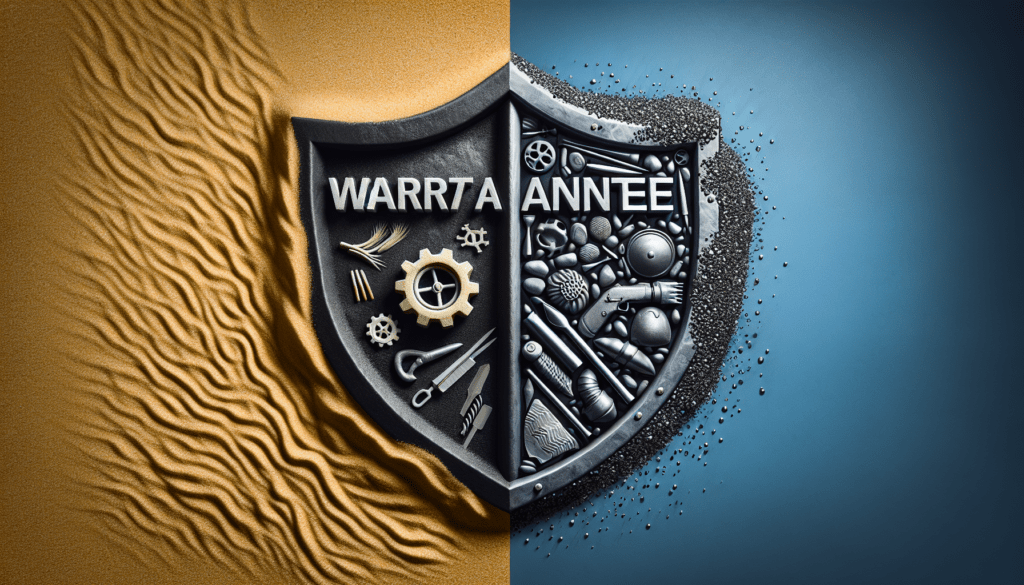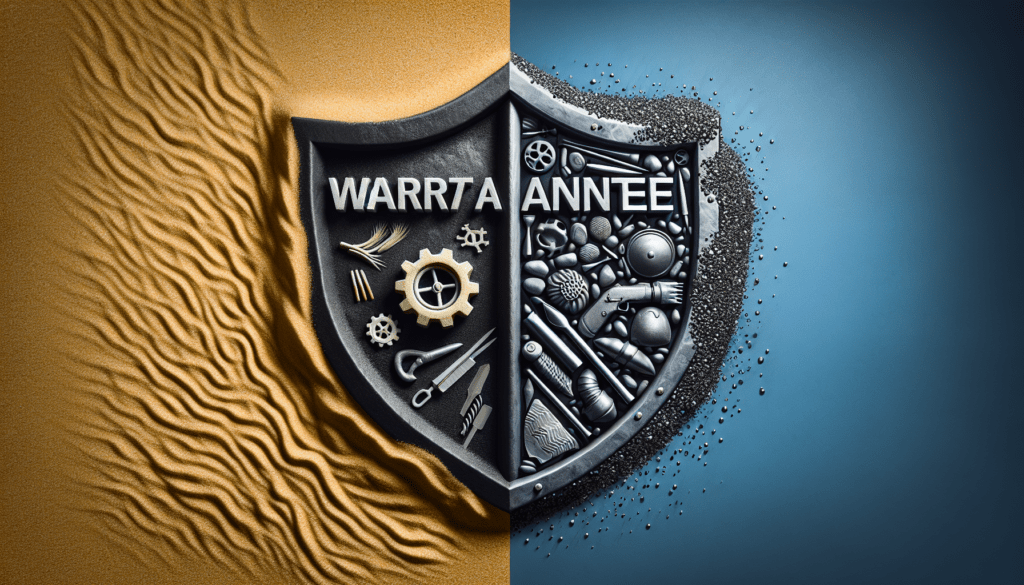In this article, we will explore the key distinctions between a warranty and a guarantee. Both terms are commonly used, but understanding their differences can save you from potential confusion and disappointment when making purchases. So, whether you’re shopping for a new gadget or considering a service, let’s dive into the world of warranties and guarantees and gain a clearer perspective on what each entails.

Definition of Warranty and Guarantee
Understanding the concept of warranty
A warranty is a type of assurance that is provided by the manufacturer or seller of a product to the consumer. It is a promise made by the manufacturer or seller that the product will perform as specified and that any issues or defects will be repaired or replaced within a certain period of time. The warranty usually comes with specific terms and conditions that outline what is covered, what is not covered, and the duration of the warranty.
Understanding the concept of guarantee
A guarantee, on the other hand, is a similar type of assurance, but it is usually provided by the seller or service provider to the consumer. It is a promise made by the seller or service provider that the product or service will fulfill its intended purpose and meet the specified requirements. Unlike a warranty, a guarantee is usually not time-limited and may be in effect for the entire lifespan of the product or service.
Legal Perspective
Laws governing warranties
Warranties are governed by specific laws and regulations that vary from country to country. These laws aim to protect consumers and ensure that manufacturers and sellers fulfill their warranty obligations. In many jurisdictions, warranties are subject to statutory rights and implied terms, which means that even if the warranty does not explicitly state certain coverage, the consumer may still have legal rights to claim a repair, replacement, or refund if the product fails to meet expectations.
Laws governing guarantees
Guarantees are also subject to legal regulations, although the specific laws may differ from those governing warranties. In general, guarantees are required to meet certain standards of quality and performance as specified by the relevant consumer protection laws. These laws may vary in terms of the duration of the guarantee, the remedies available to consumers in case of non-compliance, and the obligations of the guarantee provider.
Coverage
What warranties typically cover
Warranties typically cover defects in materials or workmanship of a product during a specified period of time. This means that if a product fails due to a manufacturing defect or faulty materials within the warranty period, the manufacturer or seller is responsible for repairing or replacing the product. Warranties may also cover certain components or parts of a product, such as the engine of a car or the motor of a household appliance. However, it is important to note that warranties do not cover damages caused by misuse, neglect, or accidents.
What guarantees typically cover
Guarantees generally cover the quality and performance of a product or service. They provide assurance to the consumer that the product or service will meet certain standards or requirements. For example, a guarantee on a washing machine might promise that it will clean clothes effectively and efficiently. If the product fails to meet these standards during the guarantee period, the seller or service provider is obliged to take appropriate action, such as repairing or replacing the product, or providing a refund.
Duration
Warranty duration
The duration of a warranty can vary depending on the product and the manufacturer. It can range from a few months to several years. Some products come with a standard warranty period, while others offer extended warranties for an additional cost. It is important for consumers to carefully review the terms and conditions of the warranty to understand its duration and any limitations or exclusions that may apply.
Guarantee duration
The duration of a guarantee may differ from the duration of a warranty. While warranties are often time-limited, guarantees may continue for the entire lifespan of the product or service. This means that as long as the product or service is being used by the original purchaser, the guarantee remains in effect. However, it is important to note that guarantees may sometimes have limitations or exclusions, so it is crucial for consumers to carefully read the guarantee terms and conditions.
Transferability
Transferability of warranties
Some warranties are transferable, meaning they can be transferred to a subsequent owner of the product. This can be beneficial for consumers who sell or give away the product before the warranty period expires. However, transferable warranties may require certain conditions to be met, such as notifying the manufacturer or seller of the transfer within a specified timeframe. It is important for consumers to check the transferability terms of the warranty to determine if it can be transferred and any requirements associated with the transfer process.
Transferability of guarantees
Unlike warranties, guarantees are typically not transferable. They are usually specific to the original purchaser of the product or service and are not extended to subsequent owners. This means that if the product or service is sold or given away, the new owner may not be able to benefit from the guarantee. However, there may be exceptions to this general rule, so it is advisable for consumers to check the guarantee terms and conditions for any transferability provisions.
Responsibilities of the Parties
Obligations of the warranty provider
The warranty provider, whether it is the manufacturer or seller, has certain obligations to fulfill under the warranty. These obligations include repairing or replacing the product in the event of a covered defect, providing necessary parts or materials, and covering the costs associated with the repairs or replacements. It is the responsibility of the warranty provider to ensure that the warranty terms and conditions are clear and easily accessible to the consumer. They must also handle any claims or disputes in a timely and fair manner.
Obligations of the guarantee provider
The guarantee provider, typically the seller or service provider, is responsible for ensuring that the product or service meets the specified requirements and quality standards as stated in the guarantee. If the product or service fails to meet these standards during the guarantee period, the guarantee provider must take appropriate action, such as repairing or replacing the product, or providing a refund or compensation. The guarantee provider should also have clear terms and conditions that outline the scope and limitations of the guarantee.
Obligations of the consumer
As a consumer, it is important to fulfill certain obligations when it comes to warranties and guarantees. These may include properly using and maintaining the product or service in accordance with the manufacturer’s instructions, promptly reporting any issues or defects, and providing necessary documentation or proof of purchase when making a warranty or guarantee claim. Consumers should also be aware of the terms and limitations of the warranty or guarantee, and follow the claim procedures outlined by the warranty or guarantee provider.
Process for Claims
Claim procedures for warranties
When making a warranty claim, the consumer typically needs to contact the manufacturer or seller and provide details of the issue or defect. This may require filling out a warranty claim form, providing proof of purchase, and describing the problem or malfunction in detail. The warranty provider will then assess the claim and determine whether it falls within the coverage of the warranty. If approved, the warranty provider will arrange for the necessary repairs or replacements, usually at no cost to the consumer. It is important for consumers to follow the claim procedures specified by the warranty provider to ensure a smooth and efficient process.
Claim procedures for guarantees
The claim procedures for guarantees may vary depending on the seller or service provider. However, similar to warranty claims, consumers are usually required to contact the guarantee provider and provide necessary details and documentation to support the claim. The guarantee provider will then evaluate the claim and take appropriate action to remedy the issue or non-compliance. This may involve repairing the product, replacing it with a new one, or refunding the consumer. Consumers should familiarize themselves with the claim procedures outlined by the guarantee provider and follow them accordingly to ensure a successful resolution.
Types of Warranty
Different types of warranties
There are various types of warranties that consumers may encounter when purchasing products. Some common types include:
-
Limited Warranty: This is a warranty that covers specific parts or aspects of a product for a defined period of time. The coverage may be limited to certain defects or malfunctions, and there may be exclusions or limitations stated in the warranty terms.
-
Implied Warranty: Implied warranties are not stated explicitly but are assumed to exist by law. They are based on the expectation that the product will be fit for its intended purpose and of reasonable quality. Implied warranties vary by jurisdiction and may differ from explicit warranties.
-
Lifetime Warranty: A lifetime warranty provides coverage for the entire lifespan of the product, as long as it is used by the original purchaser. This type of warranty can provide additional peace of mind for consumers.
Extended warranties
In addition to standard warranties, consumers are often offered the option to purchase extended warranties for an additional cost. Extended warranties provide coverage beyond the standard warranty period and may include additional benefits such as expedited repairs or replacements. While extended warranties can provide added protection, it is important to carefully consider the cost, duration, and coverage offered before deciding to purchase one.
Types of Guarantee
Different types of guarantees
Similar to warranties, there are different types of guarantees that consumers may encounter when purchasing products or services. Some common types include:
-
Satisfaction Guarantee: A satisfaction guarantee ensures that the consumer is satisfied with the product or service and provides a refund or replacement if they are not. This type of guarantee demonstrates the seller’s confidence in the quality and performance of their product or service.
-
Performance Guarantee: A performance guarantee assures the consumer that the product or service will meet specified performance standards. If the product or service fails to meet these standards, the guarantee provider will take appropriate action to rectify the issue.
-
Money-Back Guarantee: A money-back guarantee enables the consumer to request a refund if they are not satisfied with the product or service within a specified period of time. This type of guarantee allows consumers to try a product or service without the risk of losing their money if it does not meet their expectations.
Satisfaction guarantees
Satisfaction guarantees are particularly common in the service industry, where the quality and outcome of the service may be subjective. These guarantees give consumers the reassurance that if they are not satisfied with the service provided, they will either receive a refund or have the service re-performed to their satisfaction. Satisfaction guarantees can help build trust and confidence between the consumer and the service provider, encouraging repeat business and positive customer experiences.
Exceptions and Limitations
Exceptions to warranty coverage
While warranties provide valuable protection for consumers, it is important to be aware of the exceptions and limitations that may apply. Some common exceptions to warranty coverage include:
-
Misuse or Neglect: Warranties typically do not cover damages or defects caused by misuse, neglect, or improper maintenance of the product.
-
Accidental Damages: Warranties may not cover damages that occur as a result of accidents or external factors beyond the control of the manufacturer or seller.
-
Modifications or Unauthorized Repairs: Warranties may become void if the product has been modified or repaired by unauthorized individuals or if non-genuine parts have been used.
Exceptions to guarantee coverage
Guarantees also have certain limitations and exclusions that consumers should be aware of. These may include:
-
Normal Wear and Tear: Guarantees may not cover damages or issues that occur as a result of normal wear and tear over time.
-
Excluded Components or Parts: Some guarantees may exclude specific components or parts from coverage, especially if they are subject to wear or deterioration.
-
Non-compliance with Usage Instructions: Guarantees may not cover damages or malfunctions that are a result of failure to follow the recommended usage instructions or maintenance procedures.
By understanding the exceptions and limitations, consumers can better manage their expectations and ensure that they comply with the warranty or guarantee requirements to avoid any potential disputes or issues.
In conclusion, warranties and guarantees provide assurance and protection for consumers when purchasing products or services. It is important to understand the differences between the two, as well as the coverage, duration, transferability, and claim procedures associated with each. By being well-informed and following the terms and conditions, consumers can make more informed decisions, protect their rights, and have peace of mind when making purchases.



